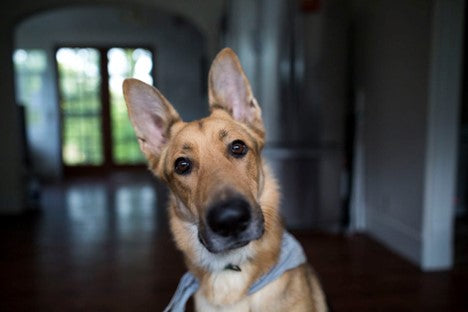GET 15% OFF WITH THE PUPPY BUNDLE
GET 15% OFF WITH THE PUPPY BUNDLE
Shop all

Understanding Dog Body Language Through Postures and Gestures
May 15, 2024 3 min read
Ever wished your dog could just tell you what they're feeling? While they might not speak our language, dogs are constantly communicating with us through their body language. Understanding these subtle signs is key to building a strong bond with your furry friend and preventing misunderstandings.
This guide will delve into the fascinating world of dog body language, exploring common postures and gestures and their hidden meanings. We'll help you decipher the wag of a tail, the position of their ears, and everything in between, so you can become a fluent speaker of "dog."
Exploring Common Dog Postures and Gestures
Tail Wags
We all know a wagging tail usually means a happy pup, but did you know the height and speed of the wag can tell a different story? A high, energetic wag often indicates excitement, while a low wag might signal uncertainty. A slow wag paired with tense body language could even be a sign of caution.
Ears Up & Alert
When your dog's ears are perked up and facing forward, they're engaged and interested in what's going on around them. This posture can indicate curiosity, playfulness, or even alertness.
Relaxed Body Posture
A relaxed dog is a happy dog! Look for a soft, loose body with their weight evenly distributed on all four paws. A relaxed tail hanging naturally and a slightly open mouth are also good signs.
Play Bow
This adorable posture is an invitation to play! Your dog might lower their front end with their rear end up, wagging their tail excitedly. It's their way of saying, "Let's have some fun!"
Submissive Roll
If your dog rolls onto their back and exposes their belly, it's a sign of submission and appeasement. This can happen when they feel threatened or want to show they're not a challenge.
Defensive Stance
A stiff posture with bared teeth, raised hackles, and a hard stare is a clear sign your dog feels threatened. In this situation, it's best to give them space and avoid making eye contact.
Understanding Your Dog's Message: Putting Body Language into Context
Remember, dog body language is a conversation, not a single word. It's important to consider all the cues together to understand the full message. For example, a wagging tail might indicate happiness, but if your dog also has flattened ears and a tense body, they might be happy but also a little unsure.
Breeds can also play a role in how dogs communicate. Floppy-eared pups might not show the same ear perkiness as breeds with pointed ears.
Creating a Calming Environment for Your Dog
Some dogs experience anxiety, which can lead to miscommunication. If your dog seems stressed or fearful, creating a safe and calming space for them at home can be helpful.
Anti-anxiety dog beds can provide a cozy and secure haven for nervous pups. For smaller breeds, consider a specifically designed bed for small dogs with calming features. These calming dog beds are filled with materials and textures proven to promote relaxation.
Beyond Body Language: Building a Strong Bond with Your Dog
Understanding dog body language is a fantastic first step, but communication is a two-way street. Consistent training with positive reinforcement helps your dog understand your cues and expectations. If you're facing challenges, consider seeking professional help from a qualified dog trainer or behaviorist.
The Benefits of Understanding Dog Body Language
By deciphering your dog's body language, you can:
- Build a stronger bond based on mutual understanding.
- Recognize signs of anxiety and address them proactively.
- Prevent misunderstandings and potential behavioral problems.
- Deepen your appreciation for your dog's unique way of communicating.
The world of dog body language is fascinating and constantly evolving. By paying attention to your dog's postures and gestures, you can unlock a deeper level of communication and build a truly special relationship with your furry companion.





